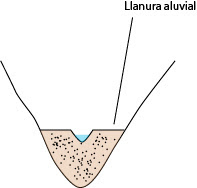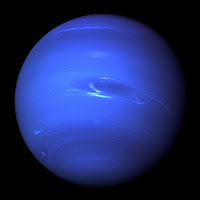En un río se puede distinguir un tramo alto, un tramo medio
y un tramo bajo.
En el curso alto predomina la erosión y el transporte sobre
la sedimentación. Es la zona de los torrentes, las pendientes fuertes, las
velocidades de flujo altos y el río tiene una gran capacidad de transporte.
La
carga es menor que la capacidad, el río erosiona, se encaja, el río discurre
por valles my estrechos en forma de V muy cerrada, muy estrecha.
 |
| Garganta del cares (por Javier Mendia García) |
En el tramo medio y en el tramo bajo los valles son más
anchos, sobre todo el el curso más bajo y el fondo está cubierto por sedimentos
acumulados por el propio río, formando una llanura aluvial. Alternan la erosión,
el transporte y la sedimentación, según el curso. Pero la erosión ya no es tan
fuerte como en el curso alto y la sedimentación es mucho más importante.
La forma del perfil de los valles formados por ríos es
típicamente en forma de V, más estrecha en tramos altos y más abierta en los
tramos medio y bajo. Y son importantes los tipos de materiales que deba
escavar. Si son muy competentes, el río formará gargantas o desfiladeros.
Existen algunos rasgos geomorfológicos asociados a los
cursos fluviales. Así, en las zonas de montaña en las que hay barrancos, cuando
alcanzan los puntos de menos inclinación, el río tiende a descargar toda su
carga sedimentaria y se forman abanicos fluviales. Si en una franja de un borde
montañoso se unen varios abanicos que se unen lateralmente, se forman los
denominados piedemotes. Son típicos de zonas áridas. Están asociados a los ríos
en sus cursos altos.
En los cursos medios y bajos el río tiende a circular por
canales que va encajando en las llanuras aluviales. En las zonas de curso
medio, predominan los canales anastomosados, que dejan en el medio islotes con
arena, cantos, etc. Estos islotes van cambiado a cada crecida del río.
En las zonas bajas o zonas de poca pendiente se forman
canales meandriformes. Como indicamos, son típicos de zonas con bajas
pendientes y de cursos bajos de los ríos y en ellos el canal describe curvas
muy marcadas. En su zona cóncava, el río tiende a escavar, a erosionar y en la
zona convexa en cambio tiende a depositar sedimentos. Por este motivo los
meandros tienden a ir haciéndose cada vez más acusados. Cuando el meandro es
muy antiguo, es frecuente que el río acabe atajando y dejando una zona de cauce
sin agua denominada meandro abandonado.
 |
| Estructuras de los ríos en el curso medio. |
Cuando en una cascada la roca de arriba es más dura que la
de abajo, la cascada tiende a retroceder, pero no a desaparecer.
 |
| Meandros (en Alaska) |
Otra forma característica son las marmitas de gigante o
pilancones. Se trata de pozos en los que entran cantos que giran por la acción
de la corriente, provocando que el hueco se agrande. Es decir, el canto hace de
taladradora. Se dan con más facilidad cuando el canto gira en un hueco que ha
sido excavado en una zona especialmente blanda.
 |
| Cascadas (por Klaus Eltrop) |
De vez en cuando podemos encontrar un tipo especial de
meandros denominados meandros encajados. Se dan cuando un río atraviesa una
llanura aluvial formada por sedimentos del propio río. El río va profundizando
hasta encontrar la roca dura que se sitúa debajo. Los meandros encajados se
producen cuando el río alcanza esta roca dura y ésta le impide cambiar el
cauce. Es decir, una vez llega a la roca dura, el meandro ya no puede cambiar o
dibujarse y la roca dura de la parte inferior refleja la forma de los meandros.
Por este motivo, los meandros que se forman son estables, fijos.
En muchas ocasiones las llanuras de inundación tienen un perfil
convexo en lugar de un perfil cóncavo. Se debe a que su cauce natural es la
llanura entera y el lugar por donde está discurriendo en este momento es el
lecho menor. Es decir, el lugar por donde está circulando en este momento está
rodeado por dos diques, los diques del lecho menor denominados malecones. Los
malecones están formados por los materiales más gruesos que lleva el río.
 |
| Llanuras de perfil convexo. |
En una crecida grande, el río se extiende por toda la
llanura, pero los cantos pesados los deja en el borde del lecho menor, pues al
desbordarse pierde energía, suelta materiales de gran tamaño en las orillas y
lo que llevará en suspensión serán materiales más ligeros, como arenas, arcillas
o limus. Por eso el borde tiende a formarse con orillas más elevadas.
Todo esto provoca que, en ocasiones, esté más elevado el
lecho por donde circula el agua que el resto de la llanura de inundación. La
formación de malecones puede provocar, en ocasiones, que los afluentes se
encuentren con los diques y que estos impidan al afluente unirse directamente
con el río principal, circulando ambos paralelos hasta que se unan en un punto
donde lo existan malecones o estos sean de menor altura.
También se puede dar, en ocasiones, la formación de capturas
fluviales. Imaginemos que hay dos vertientes, una de ellas con más pendiente y
con el nivel de base de los ríos próximo a ella, frente a otra pendiente más
suave y que tiene más alejados los niveles de base. Si hay peor clima en la
pendiente más inclinada y llueve más, en esta pendiente habrá también más
erosión. Los ríos de la pendiente más suave pueden llegar a capturar la
cabecera de los ríos de la otra pendiente, atrapando así el agua y llevándosela
la zona de pendiente más hundida.
 |
| Captura fluvial. |
Las terrazas fluviales son otra estructura que puede
aparecer en algunos ríos. Los ríos, a lo largo de su historia, experimentan
variaciones en la capacidad de erosión y sedimentación debidos a cambios
climáticos o de nivel de base, cuando por ejemplo el nivel de base
profundiza. El río pasa una temporada en
la que escarba con fuerza, seguido de otra temporada en la que deja de escarbar,
a la que sucede otra etapa de excavación y así sucesivamente. Esto originará la
formación de terrazas fluviales.
Cabe destacar que estas también pueden ser formadas debido a
levantamientos isostáticos de la corteza terrestre.
Otra posibilidad es la formación de terrazas encajadas. Se
forman cuando los episodios de erosión son más cortos que los episodios de la
sedimentación. Es decir, en los ciclos erosión-sedimentación, predomina la
sedimentación.
En cualquiera de los casos, en las terrazas fluviales la
llanura más baja es la más reciente.
 |
| Terrazas fluviales y terrazas fluviales encajadas. |
Al estudiar los ríos, resulta muy importante el estudio del
perfil vertical de sedimentos. Los sedimentos depositados en horizontal
combinan lentejuelas o lentejones de gravas y arenas entre arcillas.
Corresponden a posiciones del lecho menor. Los sedimentos de los lentejones son
los depositados por el cauce cuando cambia de posición. Las arcillas son
depositadas en las subidas, durante las crecidas.
En los cursos altos, los depósitos que dejan dan lugar a los
abanicos fluviales. Hay una mezcla de materiales de distinto tamaño, mezcla de
rocas distintas y poco redondeamiento en los cantos, ya que el transporte es
muy pequeño, muy corto. Se dice que los sedimentos están poco calibrados, por
el tamaño y que presentan poca madurez, por lo poco redondeados que se
encuentran.
Estos depósitos fluviales cuando son compactados se
convierten en rocas sedimentarias. Son diferentes en diferentes niveles. Las
rocas sedimentarias que generan los depósitos fluviales son brechas y
conglomerados en los abanicos fluviales; en los abanicos aluviales tienden a
ser solo conglomerados; así como conglomerados y areniscas con pizarras en los
depósitos de las llanuras de inundación.
 |
| Delta de ebro (por Gons) |
Esto no quiere decir que todos los conglomerados, areniscas
o pizarras sean de origen fluvial. Lo que, sin embargo, es cierto, es que las calizas
no son nunca de origen fluvial, siendo de origen marino la mayoría de ellas, o
de origen lacustre otras.



































